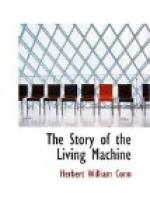No less intimate is the relation of these problems to the doctrine of evolution. Evolution tries to account for each moment in the history of the world as the result of the conditions of the moment before. Such a theory loses its meaning unless it can be shown that natural forces are sufficient to account for living phenomena. If the supernatural must be brought in here and there to account for living phenomena, then evolution ceases to have much meaning. It is undoubtedly a fact that the rapidly developing ideas along the above mentioned lines of dynamical biology have, been potent factors in bringing about the adoption of evolution. Certain it is that, had it been found that no correlation could be traced between vital and non-vital forces, the doctrine of evolution could not have stood, and even now the special significance which we shall in the end give to evolution will depend upon how we succeed in answering the questions above outlined. The fact is that this problem of the mechanical explanation of vital phenomena forms the capstone of the arch, the sides of which are built of the doctrines of the conservation of energy and the theory of evolution. To the presentation of these problems the following pages will be devoted. The fact that both the doctrine of the conservation of energy and that of evolution are practically everywhere accepted indicates that the mechanical nature of vital forces is regarded as proved. But there are still many questions which are not so easily answered. It will be our purpose in the following discussion to ascertain just what are these problems in dynamical biology and how far they have been answered. Our object will be then in brief to discover to what extent the conception of the living organism as a machine is borne out by the facts which have been collected in the last quarter century, and to learn where, if anywhere, limits have been found to our possibility of applying the forces of chemistry and physics to an explanation of life. In other words, we shall try to see how far we have been able to understand living phenomena in terms of natural force.
==Outline of the Subject==.—The subject, as thus presented, resolves itself at once into two parts. That the living organism is a machine is everywhere recognized, although some may still doubt as to the completeness of the comparison. In the attempt to explain the phenomena of life we have two entirely different problems. The first is manifestly to account for the existence of this machine, for such a completed piece of mechanism as a man or a tree cannot be explained as a result of simple accident, as the existence of a rough piece of rock might be explained. Its intricacy of parts and their purposeful interrelation demands explanation, and therefore the fundamental problem is to explain how this machine came into existence. The second problem is simpler, for it is simply to explain the running of the machine after it is made. If the organism is really a machine, we ought to be able to find some way of explaining its actions as we can those of a steam engine.




